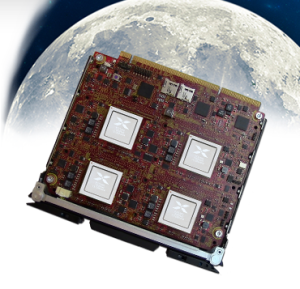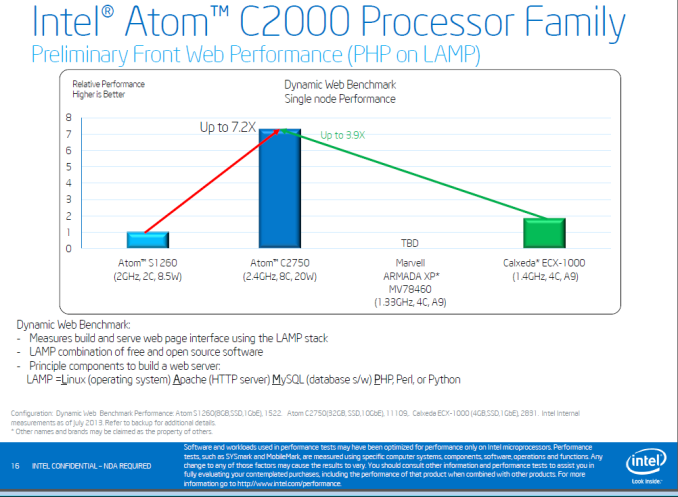The Next Generation of Micro Server SoCs: ECX-2000 vs Atom 2000
by Johan De Gelas on October 29, 2013 5:59 AM EST- Posted in
- Enterprise
- Intel
- Arm
- Calxeda
- Avoton
The benchmarking team of Intel Portland did their best to produce some really interesting benchmarks at the last server workshop in San Francisco, but many of the benchmarks did not work well on the ECX-1000 due to the very limited 4 GB RAM capacity. The most interesting benchmark can be found below: a front end web performance benchmark with high network traffic.
In this benchmark, Intel finally admits that the S1260 is nothing to be excited about. The Intel findings are very similar to ours: the ECX-1000 beats the the Atom S1260 by a wide margin in typical server workloads. So where will the ECX-2000 end up? We can not be sure, but we can roughly estimate that it will land somewhere between being 3 to 4 times faster than the Atom S1260. That is not enough to beat the Atom C2750, but that is after all a 20W TDP chip and the top SKU. Digging deeper in the Intel docs, we find that the C2730 at 1.7 GHz (12 W TDP) consumes about 20W for the whole server node (16 GB and 250 GB HD) and the C2750 about 28W when running SPECint_rate_2006. The harddisk will have consumed very little, since the SPECint_rate_2006 benchmark runs out of memory.
The ECX-2000 at 1.8 GHz will probably need roughly 12-16W per server node. So our first rough estimates tell us that the C2730 is out of the (performance) reach of the ECX-2000, and that Calxeda's estimate of the C2530 is right on the mark.
However, the story does not end there. The total power consumption of the ECX-1000 based Boston Viridis server we tested was remarkably low, the very efficient network fabric made sure there was little "power overhead" (PHYs, Backplane,...). This Fleet Fabric has been improved even further, so there is a good chance that the ECX-2000 based servers will offer a very competitive performance/watt, although the Atom C2730 has an edge when the application benefits from more threads. But when that is not the case, i.e. scaling is mediocre beyond 4 threads, the tables might turn. Anyway, there is a very good chance that the ECX-2000 is very competitive with the 4-core Atoms, to say the least.

There is indeed a reason why HP will use the Calxeda SoC in its new Moonshot server cluster in 2014. The picture above shows such a moonshot module. We felt that the Atom S1260 SoC was a bad match for the HP moonshot, but "HP's Moonshot 2.0" will be an entirely different story. And for those of us with less cash to burn we are looking forward what Penguin computing and Boston will make off their ECX-2000 based server.
Next stop, the 64-bit SoC code-named “Sarita,” based upon the 50% faster Cortex-A57 core, which is pin-compatible with the ECX-1000 and new ECX-2000. This reduces development time and expense for the ODMs. But right now, we can look forward to some interesting microserver comparisons in Q1 2014...











45 Comments
View All Comments
Khato - Tuesday, October 29, 2013 - link
Awwwww, from the title I was all excited to see an actual review of these two server SoCs, not just a feature comparison. Oh well, just have to wait awhile longer for that to come eh?krumme - Tuesday, October 29, 2013 - link
Johan just couldnt wait :). I understand him. From this arm generaion on its starting to become interesting. When was the last time something this happened?Khato - Tuesday, October 29, 2013 - link
If by interesting you mean a performance bump in line with expectations and the ability to address enough memory for it not to be a major limitation, than sure, this generation becomes interesting. Personally I found the first iteration more interesting for the simple fact that it actually beat Intel to the punch and provided a superior solution for the particular niche it was good for. Whereas this time around, well, the C2530 is almost at the bottom of Intel's Avoton lineup - only the one dual core model is below it. The more important point being that for any reasonably threaded workload Intel offers 8 core SKUs which, due to the fixed power consumption per node, greatly increase performance while only bumping up power consumption by ~33%.The next round might be a bit more interesting but I doubt it. Note how the ECX-2000 projected performance increase is pretty much exactly as much as the projected power increase over the ECX-1000? And that's with going from a 40nm process to 28nm. Why exactly should we expect anything more from the next generation?
JohanAnandtech - Wednesday, October 30, 2013 - link
Your reasoning has some good points. However: the higher RAM capacity and CPU performance really allows that new kind of apps run on this thing. Apps that can benefit from the excellent network fabric for example. It will be interesting to see which realworld apps are bottlenecked by the limited CPU power and which ones are bottlenecked by network. Realworld server applications can sometimes be extremely different from the typical benches used. The ECX-2000 will not win any raytracing bench, but Calxeda does have a fighting chance turn as a Content Delivery Server or Drupal based server. All I am saying is, don't judge on raw performance or perf/watt.wsw1982 - Wednesday, October 30, 2013 - link
So, the point is "don't judge on the performance, don't argue on the perf / watt, don't judge on the software, don't judge on the availability, don't judge on the power consumption (no data is given)." But see, "we have 10 g eth"JohanAnandtech - Wednesday, October 30, 2013 - link
I am saying that raw perf/watt does not translate in realworld perf/watt when running realworld server apps. The S1260 looked on par with the ECX-1000 in the benchmark: about the same raw performance (integer crunching benches) and 8.5W vs 6W. The reality was that a S1260 server node needed 15 to 20W (vs 8W) and performed up to twice as slow in real server loads. That is 4-5 (!!) worse perf/watt ratio than expected from integer benches and TDP. Not saying the C2000 will be the same, just illustrating how far real server workloads can be from the other benchmarks.hoboville - Thursday, October 31, 2013 - link
He's saying the ARM chip, like all good RISC chips is good for certain applications like CDN. Real world and on other applications it might not hit its stride.Real world also means that, because the ARM has less RAM and fewer cores, it has the potential to be bogged down in scenarios where there is a higher demand than the cache / RAM / threads can handle. It may be that those requests only require a small amount of network bandwidth, but if the processor can't schedule those tasks...then the CPU is a problem. However, if the CPU is handling a simple decode of a massive file, it can stream the results faster than network bandwidth. Real world perf is subject to a large degree of variability in task type.
JohanAnandtech - Wednesday, October 30, 2013 - link
I understand. We simply have to wait until the ODM solutions on ECX-2000 are validated.geekfoo - Friday, November 1, 2013 - link
wow, whoever they have laying out these moonshot module/sleds wants shooting :)you could easily get 8 or even 16 SoC in that same space today im sure, perhaps even more.
Oh and Johan as you say you cant really compare OC but you should probably go into petty cash and get a few cheap Hardkernel ARM big.LITTLE A7 + A15 Exynos 5410 Octa-Core ODROID-XU's for generic testing etc
http://www.hardkernel.com/renewal_2011/products/pr...
geekfoo - Friday, November 1, 2013 - link
i find these older cortex tests interesting toohttp://www.phoronix.com/scan.php?page=article&...
and PandaBoard bearing an OMAP4430 with 1.0GHz Cortex-A9 MPCore)
http://www.phoronix.com/scan.php?page=article&...